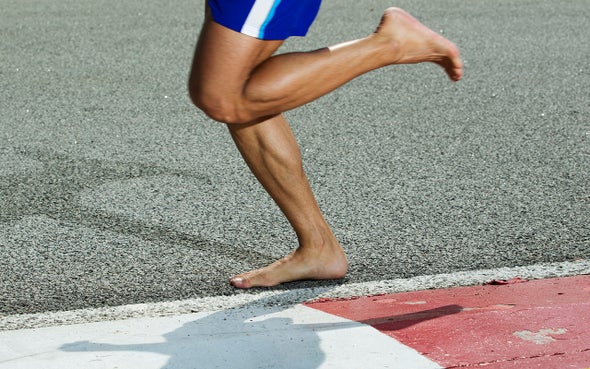Walking on Eggshells
"There has been debate about barefoot running being good or bad, or shoes being good or bad, and this is the wrong debate. It should be about what the costs and benefits of shoes are and how we can better understand how shoes affect our feet, our health, the way we walk."
"We live in this weird world where calluses are bad, like you have a problem with your shoe, and you go to a podiatrist, and they remove them. But until recently it was abnormal not to have calluses." "We’ve lost touch with our bodies in some respects and this is a good example of that. When we tell our results to barefoot people, they say, 'Tell me something I don’t already know'."
"I'm not saying people shouldn't wear shoes."
"If your feet can’t sense what’s going on on the ground, maybe you’re more susceptible and more vulnerable [to falls], and shoes may be a part of that. If we can give people’s brains, their reflexes, more information, that might help them."
"I find it unimaginable to be barefoot in middle of Europe in the Ice Age, but then again, all the other animals in Europe during the Ice Age were barefoot—so maybe our cousins, the Neanderthals, were able to handle it just fine."
Daniel E. Lieberman, Edwin M. Lerner II Professor of Biological Science, chair, Department of Human Evolutionary Biology, Harvard University
"We tested the sense of touch, the dynamic sense of what you feel on the ground. We found these stiff calluses don’t prevent any communication between the force of the feeling of what you are stepping on and what makes its way to the nerve cell to be transmitted to your brain."
Nicholas B. Holowka, postdoctoral fellow, Graduate School of Arts and Sciences, lecturer in Human Evolutionary Biology
 |
| Credit: Getty Images |
A new study recently published in the journal Nature, posits that when people wear shoes it alters their natural way of walking, a manner of walking that nature designed us for, shoeless. The study builds on earlier research whose findings popularized barefoot running. The study conclusion was that when walking, people move differently when barefoot than they do when their feet are encased in shoes. Moreover the sensitivity of the sole of the foot to the ground differs as well. An unclad foot is directly exposed to the texture of any surface being walked upon, whereas the sole of the shoe interrupts that sensitivity to a degree without entirely erasing it.
What the researchers feel, however, is that the differences in sensitivity, in feeling between the sole of the foot and the surfaces being trod upon may have the potential to affect balance (which presumably is compensated for in the way the body responds to the differences) as well as joint loading. One of Dr. Lieberman's takeaways, is that this could lead to arthritis for some people. The intimation is that it may be advantageous to walking and running with bare feet. One of the surprise findings was the advantage of a bare foot coming directly in contact with the ground, is the gradual build-up of calluses.
Yes, those are the calluses that are seen as an impediment to good foot health, that we take as a signal that something is wrong. When calluses develop, on the other hand, as a result of constant direct contact with the ground by a bare foot, they tend to serve as a protective screen, making the foot while not impervious to harm from stones, roots, sharp objects, better able to absorb the shock that interacting directly with those objects results in, on contact.
Dr. Lieberman has wondered at the function of calluses even while most people consider them unsightly, needing to be removed. After mulling the issue over, that the calluses could conceivably be viewed as an advantageously unacknowledged utilitarian purpose, he decided to launch a study to revolve around that hypothesis. He and a team of collaborators took to comparing how a select subject group in Kenya walked, with and without shoes, then comparing the results with a similar group in Boston.
At the Lieberman lab in Boston when male and female volunteers walked on treadmills barefoot their feet hit the g round in a manner very similar to the unshod walkers in Kenya, but when the volunteers wore average cushioned sneakers, there was a subtle alteration in their walking pattern. Their feet struck the ground slightly more lightly initially, yet the stride impacts lingered longer than when the subjects were barefoot. Impacts of this nature tend to move up, dissipating through legbones, ankles and knee joints.
 |
| Custom-built device used to measure tactile sensitivity of foot at different frequencies. Credit: Daniel Lieberman |
The shorter, sharper jolts felt when people walk barefoot on the other hand, are likelier to rise through soft muscles and tendons in the body, according to Dr. Lieberman. Suggesting that the way people walk is determined by what is worn on their feet. Shoes have a protective function, and absorb the slight pounding that feet undergo while walking, but at the same time they alter strides and over time have the potential to increase pressure and wear on leg joints.
The particular calluses that arise when walking shoeless on the other hand, shield the foot from discomfort of coming in contact with objects on the ground while barefoot, even while not reducing contact with and the ability to feel the ground's complex texture. Which suggests that people experiencing concerns over balance, and less concerned over how their feet would appear with calluses might benefit from walking about barefoot at times.
 |
Comparing the foot of a shoe
wearer vs. the barefoot walker. In Kenya, researchers measured the
biomechanics of the barefoot walker.
Photos by Thomas Milani and Daniel Lieberman
|

0 Comments:
Post a Comment
<< Home